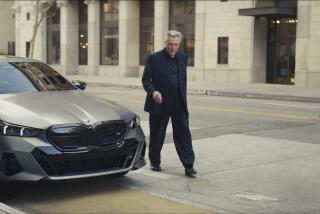C-C-C-Catch the wave. : MAX HEADROOM : New TV Marketing Star Finds Success Is Going to His Head
- Share via
The name Max Headroom may not register with most Americans over 30. But the half-human, computer-generated talk show host leaped closer to media superstardom early last month when not one but two books and a video about him arrived on store shelves.
It was the lastest salvo in a shrewd promotional campaign that has captured the imagination of the fickle--but lucrative--youth audience and boosted the financial fortunes of Max Headroom’s creators. This year, they expect to generate revenue of more than $2 million from at least two major product endorsements plus Max Headroom T-shirts, a two-hour pilot for ABC television and a score of other licensing agreements.
Despite the onslaught, however, most parents and middle-aged Americans remain mystified by all the hoopla.
“He’s a strange-looking character,” said Bob Cohen, a 43-year-old West Hollywood pharmacist, who has a son, 16, and daughter, 13, who regularly watch Max Headroom on cable television. “I personally don’t pay much attention to him. I’m amazed at what people see in him.”
Indeed, even in television’s world of hype and make-believe, Max Headroom--the brainchild of a British record executive and a London television editor--is an unlikely star.
The blond-haired, blue-eyed character, licensed by Chrysalis Visual Programming, a division of London-based Chrysalis Group Ltd., is technically non-existent. He is said to be played by Canadian actor Matt Frewer, aided by heavy makeup and a computer that alters his voice. The resulting effect, however, is neither inanimate like cartoons nor life-like.
Seen regularly on British TV and six times a month in the United States over the Cinemax pay television channel, Max Headroom hovers on the television screen like some ethereal electronic maven; he’s shown only from the shoulders up and speaks in preening, sputtering fits on subjects ranging from sex and sports to music and fashion.
“He’s the first character that’s been created for a new generation of people,” observed Peter Wagg, former head of creative services at Chrysalis and one of Max’s creators. “He speaks their language.”
And, too, the language of Madison Avenue.
At least a dozen companies, including Viacom International and Marvel Comics Group, attended a recent meeting in New York earlier this month to discuss securing licensing rights to use Max Headroom in their marketing campaigns.
Southland Corp.’s 7-Eleven is negotiating to use Max to advertise their new MovieQuik video rentals. And Hallmark Cards is discussing marketing a line of greeting cards using Max Headroom, according to a company spokeswoman.
Those developments are in addition to the book, “Max Headroom’s Guide to Life” and a Karl Lorimar Home Video release and book both called “Max Headroom--20 Minutes Into the Future” that arrived at bookstores this month.
All in all the talk show host will bring in more than $2 million in revenue in 1986 and could double that total next year, said Terry Connolly, Chrysalis group managing director.
Coca-Cola Co., the most visible licensee thus far, secured the beverage rights to Max Headroom last year in a one-year, $400,000 deal to lure the young soft drink buyers it was losing to Pepsi.
The Max Headroom campaign, advertising executives say privately, is the most exciting Coca-Cola campaign since the beverage maker abandoned its popular “Coke Is It” series featuring actor Bill Cosby.
Experts say the new commercials seem to have awakened Coke from a creative slump that saw the beverage maker experiment with everything from patriotic-themed ads, featuring the Statute of Liberty and images of the nation’s past, to a recent spot that used trick photography to show the contents of a can of Coke defying the laws of gravity by flowing horizontally across the screen.
In igniting Coca-Cola’s bid to capture the crucial market of 12- to 30-year-olds who make up the heaviest consumers in the $25-billion-a-year soft drink market, Max Headroom threatens to undermine the gains of rival beverage maker Pepsi-Cola, which had aggressively pursed younger consumers in recent years with a series of television ads featuring youthful heroes such as actor Michael J. Fox of television’s “Family Ties” and singer Michael Jackson.
“The Max Headroom commercials are definitely ahead of Pepsi’s in terms of popularity,” said Dave Vadehra, president of the New York-based survey firm Video Storyboard Tests Inc. “After Mean Joe Greene, this is the best commercial that’s come out of Coke.”
Coca-Cola has not released sales figures since the commercials started running last April. But a spokesman for the Atlanta company says its $25-million soft drink advertising blitz, in which Max Headroom exhorts “Cokeologists” to “catch the wave,” has made the smarmy pitchman recognizable to 76% of American teen-agers.
“A lot of politicians would like to have that recognition factor,” spokesman Roy Flemming boasted.
Pepsi, however, isn’t overly impressed about the campaign.
“If you look at the Max Headroom commercials, they look very hip; they look like Pepsi commercials,” said Stuart Ross, a Pepsi spokesman. “But even his (Max’s) considerable talents are not enough to help Coke. You have to keep your product and your image fresh, too.”
Indeed, fads have a way of fading faster than the fizzle in an opened can of soda.
“The reason why Coca-Cola shifted their strategy from the patriotic was because the All-American appeal was not effective in reaching the young age group which uses these products,” said Valerie S. Folkes, an assistant professor of marketing at USC. “Coke is jumping on the same band wagon that Pepsi is using. But that can get to be very expensive. Fads come and go very quickly.”
More to Read
The biggest entertainment stories
Get our big stories about Hollywood, film, television, music, arts, culture and more right in your inbox as soon as they publish.
You may occasionally receive promotional content from the Los Angeles Times.










